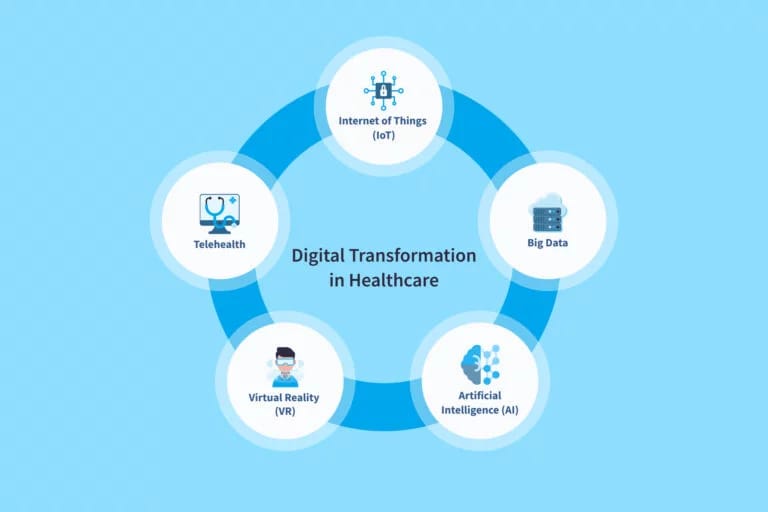Digital Transformation in Healthcare
Introduction
The healthcare industry has become more digital since the COVID-19 pandemic. Investor funding for healthcare digital transformation has grown significantly. Data analytics, health applications, and telemedicine received the most funding in 2020.
Online appointment booking and patient portals have made healthcare more convenient and accessible. This has reduced administrative burdens, wait times, and appointment cancellation rates for healthcare facilities. 92% of healthcare professionals improved with digital transformation.
Telemedicine, patient portals, and in-hospital monitoring will be discussed in this blog. Before using any services, you should understand healthcare digital transformation challenges.
What is Digital transformation in healthcare?
Digital transformation in healthcare means integrating technology into all aspects of care. Patients benefit from this. It streamlines hospital operations and improves patient care. Digital innovation in healthcare is an investment to transform systems, lower costs, and make healthcare affordable.
Healthcare and digital transformation depend on integrating technologies to streamline workflow. These include electronic health records, telemedicine, health information exchanges, artificial intelligence, health apps, and wearable devices. These digital tools have improved healthcare quality, efficiency, and accessibility.
Digital healthcare transformation has accelerated since COVID-19. In March 2020, the CDC reported a 154% increase in telemedicine.
Digital health tools will grow to $660 billion by 2025, according to Statista. According to Global Market Insights, Inc., the global digital health market will reach $426.9 billion in 2027 with a 17.4% CAGR. 88% of organizations invested in patient care and engagement in 2021, according to the Deloitte Center for Health Solutions.
Individuals value digital healthcare transformation because they want human-centered models. More than 40% of patients surveyed by Deloitte Inc. wanted to use telehealth after the pandemic. Digitizing healthcare was expected to improve patient outcomes by 92% of respondents in another survey.
Given the benefits of healthcare digitalization, let's explore the concept and challenges of digital transformation in healthcare.
Digital transformation in healthcare Benefits
Increased workloads and burnout require assistance for doctors. Healthcare demand is outpacing resource supply. Your facility's digital transformation can improve patient outcomes, experiences, and staff satisfaction.
Therefore, understanding healthcare digital transformation's benefits is crucial. Let's discuss the top three advantages of digital healthcare.
The top three benefits of a digital healthcare strategy are:
1.Patient Outcomes Improved
Digital transformation in healthcare improves care coordination, personalized treatment plans, and patient engagement. Patients can use telemedicine and mobile health and well-being apps to get healthcare remotely. Doctors can quickly diagnose and track patient medication adherence.
2.Efficiency Increased
Healthcare efficiency and streamlining are other benefits. By quickly accessing patient data, electronic health records (EHRs) reduce administrative burden and improve care coordination. Online appointment scheduling and billing are available to patients. It saves time and money and reduces manual errors. You can reallocate hospital staff and use resources more efficiently.
3.Decisions Based on Data
Digital innovation in healthcare can provide real-time data and analytics for better decision-making. Predictive analytics can identify high-risk patients for readmission or health issues. Healthcare providers can prevent unnecessary hospitalizations by intervening earlier. You can also optimize resource allocation, supply chain management, and population health trends.
Visualizing patient outcomes and population health trends helps identify areas for improvement. With precise data collection, storage, and analysis, you can improve patient outcomes.
Digital Healthcare Solutions' Six Biggest Use Cases
1. Healthcare on-demand
Healthcare patients want convenience and accessibility. Telemedicine, mobile health apps, medical records, and virtual consultations can be done on mobile devices or computers.
Remote patients benefit from on-demand healthcare. Patients can receive remote consultations, diagnosis, and treatment at home. This reduces healthcare disparities and ensures all patients have access to facilities.
2. Reservations Online
Online appointment booking can make scheduling appointments easier for patients. Patient adherence is improved by this tool's automated email and text reminders.
It automates healthcare providers' follow-up appointment booking and reduces data entry. Demographics, medical history, and appointment history are included. Healthcare providers can better understand their patients' needs and provide more personalized care. Administrative costs can be reduced and staff productivity increased.
3. Queue Management Virtual
By reducing patient numbers in waiting rooms, virtual queue management maintains social distance. Patients don't have to wait in a crowded waiting room. Your business can profit from resource reallocation.
4. Portals for Patients
The patient portal offers a complete solution to patients and care providers. It provides secure online access to medical records, test results, and appointment schedules. Patients can ask doctors questions and get answers. Online appointment scheduling, pharmacy refills, and bill payment streamline administrative processes.
5. Telemedicine
Telemedicine lets patients consult with doctors via videoconferencing or patient apps. For patients who can't get to a hospital, this is helpful. It can help doctors manage chronic patients and follow up.
Healthcare providers can use digital tools to monitor patients' symptoms and vital signs and adjust treatment plans. In 2020, Medical Economics found that 91% of patients found telemedicine helpful in keeping appointments and managing prescriptions and refills.
6. Patient Monitoring In-hospital
Patients' vital signs and health status are monitored continuously during in-hospital monitoring. It helps prevent hospital complications by providing real-time patient data. Individualized treatment plans can be provided by doctors. This improves treatment outcomes and patient satisfaction.
Digital Transformation in Healthcare: Challenges
Although digital transformation in healthcare has made patients and providers' lives easier, adopting new technologies creates redundancies. Patients worry about privacy, and some see it as a complicated system with regulatory issues.
Obstacles for Doctors
*Task-related
Healthcare providers must change their workflows to incorporate technology. It's hard to teach staff to use new tech.
*System and Patient Obstacles
To avoid care disruptions, healthcare providers must keep software updated and address issues quickly.
Obstacles for Healthcare Organizations
* Protecting Patients
Patient data security and privacy are the biggest challenges. Data breaches and cyber-attacks are major concerns for healthcare organizations because they store so much sensitive data. To safeguard patient data, you need strong cybersecurity.
*Institutional obstacles
Healthcare facilities may lack the infrastructure to install a digital healthcare solution, which can cost money and resources. To maximize digital benefits, each solution needs a cost-benefit analysis.
Problems for Patients
*Usability and Resource
Some patients may not have internet access or be tech-savvy, making digital healthcare solutions inaccessible. Organizations must ensure a user-friendly hybrid approach to digital healthcare solutions.
Conclusion
Post-pandemic healthcare organizations have new opportunities. Digital transformation benefits healthcare in this blog. Numerous services include real-time and predictive data and analytics, improved resource allocation, and comprehensive data collection.
On-demand healthcare, telemedicine, online appointment booking, virtual queue management, patient portals, and in-hospital monitoring are part of a digital healthcare strategy.
Prioritise patient privacy, data security, and effective technology use in your healthcare facility when implementing healthcare solutions.
Author Bio:
Adarsh Kumar Arya is a highly skilled Product Manager & Solution Sales Expert and an experienced technical writer passionate about communicating complex information clearly and concisely. With a strong background in Digital Technologies and a keen eye for detail, Adarsh excels in translating technical concepts into user-friendly documentation.


No comments yet